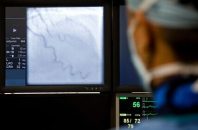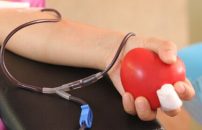All interventional cardiologists must be able to perform a pericardiocentesis. Whether we deal with a chronic total occlusion, a supposedly simple coronary angioplasty (we all have witnessed the perforation of a supposedly risk-free coronary artery), or a transcatheter aortic valve replacement (whose rise gave us another significant source of tamponades), we must all be ready…
Contrast Induced Kidney Injury, Infamous Problem with No Magical Solutions
In patients at high risk of developing kidney complications undergoing angiography, we did not observe benefits when administering intravenous sodium bicarbonate vs. saline, or oral N-acetylcysteine vs. placebo, as to the prevention of death, dialysis or persistent deterioration of kidney function at 90 days, or the prevention of contrast induced kidney failure. Many small studies…
Elderly Patients with ACS: Clopidogrel or Reduced-Dose Prasugrel?
Elderly patients are at elevated risk of both ischemic and bleeding complications after an acute coronary syndrome (ACS), and display higher platelet reactivity under clopidogrel when compared to younger patients. A 5-mg dose of prasugrel would provide more predictable platelet inhibition than clopidogrel in elderly populations, without the risk of bleeding entailed by the full…
Peri-Procedural Infarction: More Frequent than and Not as Innocent as We Thought
Almost 30% of all patients experience some degree of myocardial injury after elective angioplasty, a statistic associated to an increase in cardiovascular events at 30 days and 1 year, according to this study recently published in Eur Heart J. The study only included consecutive patients who underwent elective angioplasty with a negative troponin level at admission. The…
Peri-Procedural Infarction: More Frequent than and Not as Innocent as We Thought
Almost 30% of all patients experience some degree of myocardial injury after elective angioplasty, a statistic associated to an increase in cardiovascular events at 30 days and 1 year, according to this study recently published in Eur Heart J. The study only included consecutive patients who underwent elective angioplasty with a negative troponin level at admission. The…
ACC 2018 | Risk of MI in Non-Cardiac Surgeries
One in five patients presenting perioperative MI during non-cardiac surgery should be readmitted within 30 days after surgery, and one in seven dies within the same period, according to the new study presented at ACC 2018 scientific sessions and simultaneously published in Circulation. These infarctions could be considered a iatrogenic complication, given the obvious lack of proper…
ACC 2018 | SECURE-PCI: High Dose of Statins pior PCI Could Help
Patients undergoing acute coronary syndrome (ACS) loaded with a high dose of statins prior diagnostic catheterization do not seem to benefit from this strategy. However, when looking at those undergoing PCI alone (excluding all patients who had received surgery or medical treatment), the benefit appears as a reduction of combined major events. The benefit of atorvastatin loading…
ACC 2018 | SMART-DATE: 6 Month DAPT Results Suboptimal in ACS
This study compared 6 vs 12 or more months of dual antiplatelet therapy (DAPT) in patients undergoing acute coronary syndrome (ACS) receiving contemporary DES, and it did not find differences in combined endpoint. However, looking at primary endpoint components separately, there were more infarctions in patients with a short DAPT scheme that we cannot ignore. Prolonging antiaggregation…
ACC 2018 | DEFINE-FLAIR Sub-Analysis: iFR More Comfortable, Faster, and Much Cheaper
Using instantaneous wave-free ratio (iFR) to guide decisions on revascularization of intermediate lesions is cheaper than using fractional flow reserve (FFR). Based on costs from the DEFINE-FLAIR trial, researchers estimate the difference to be almost USD 1000. This should not be seen as good news for any given technology (iFR, in this case), but for physiologic…
ACC 2018 | COMBO: New Stent with Thin Struts and Pro-Healing Membrane
The new COMBO stent, comprised of thin struts plus a bioengineered layer of endothelial progenitor cells, is safe and effective at 1 year, according to this registry (the largest study on this device to date). This new stent could provide a better option for patients at high risk for bleeding who may not be able to…
Tips to Prevent Radial Occlusion after Catheterization
The transradial access is the preferred access site for patients undergoing acute coronary syndrome. Compared to the transfemoral access site, it reduces the risk of all cause death, vascular complications and major bleeding. Radial artery occlusion is the most frequent vascular complication associated to this approach, though it rarely results in clinical consequences such as ischemia, given the…









